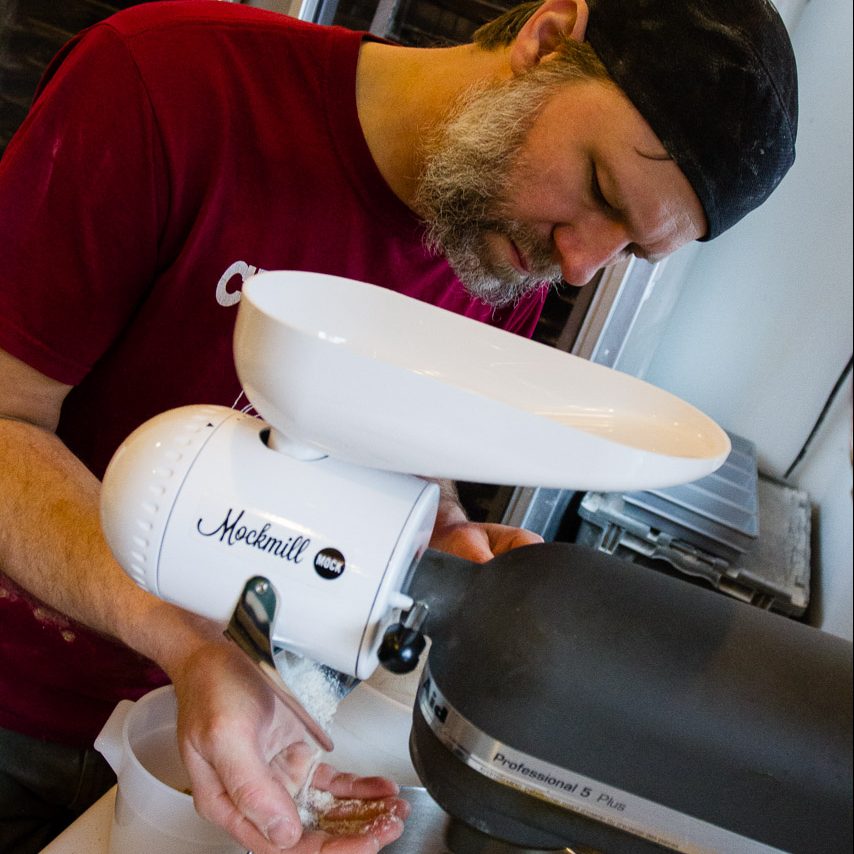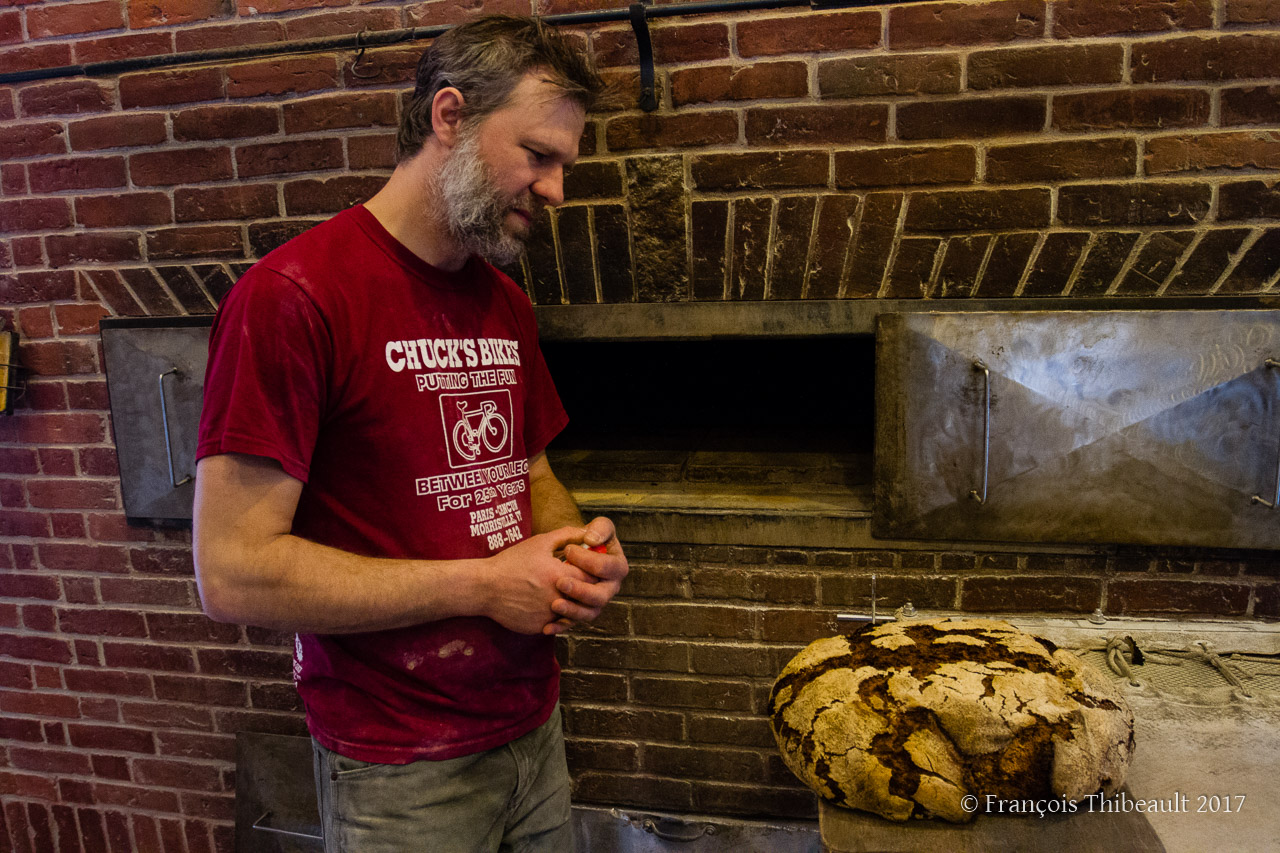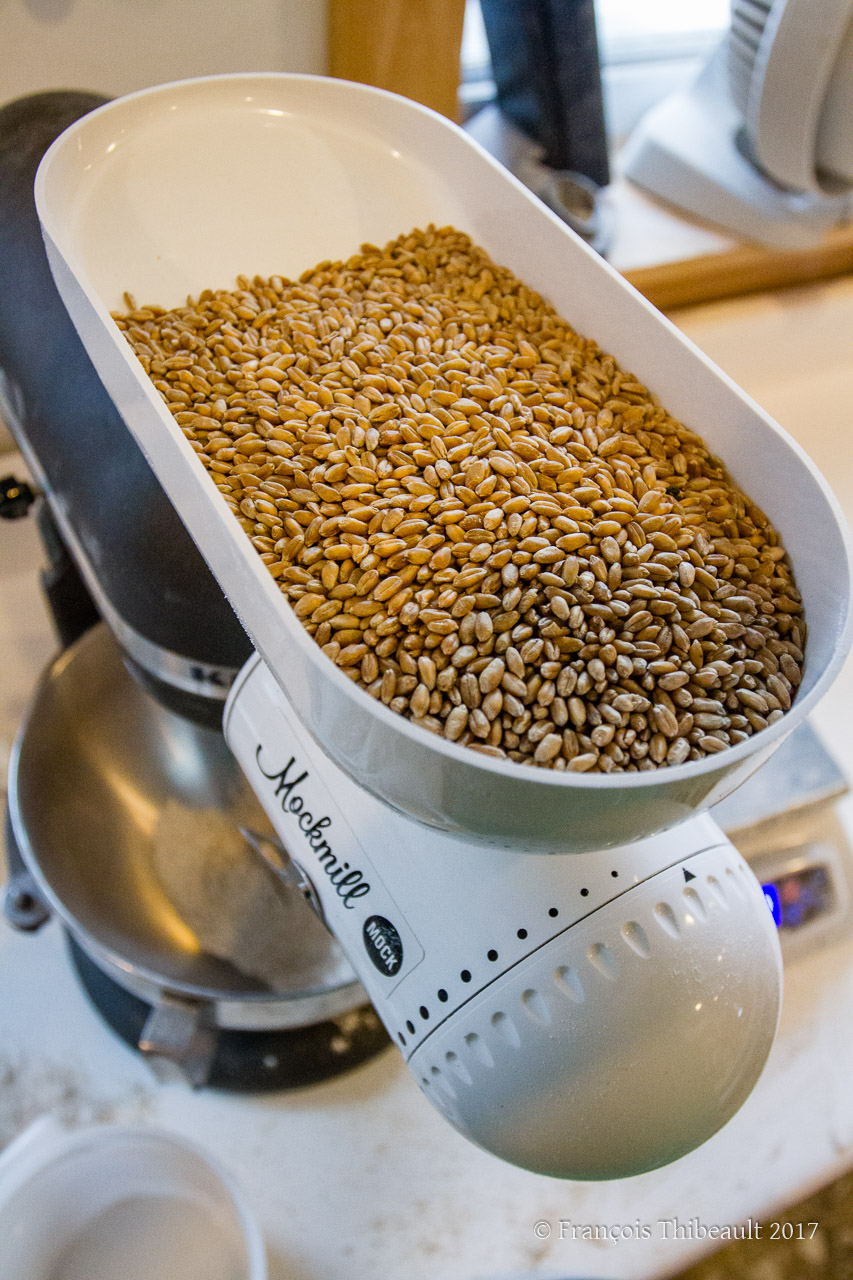Testing the Mockmill with Andrew Heyn at Elmore Mountain Bread

By two o’clock in the afternoon, Blair Marvin and Andrew Heyn had finished baking bread at Elmore Mountain Bread (read the full story in Bread Magazine issue 21). Blair had gone to deliver the loaves to shops and customers. Andrew kept a watchful eye on two 5-kilos (11 lbs) rye loaves slowly baking in the oven. He was baking experimental loaves for Jasper Hill Farm (Vermont, United States), a farm that ripens a great variety of cheeses. The cheesemaker was going to inoculate the loaves with Penicillium roqueforti, the fungus needed to make Roquefort cheese. The loaves had to have a very moist crumb and a carbonized crust (read more).
As the bread baked in the oven, Andrew and I were talking about milling and fresh flour. I asked him how home bakers could start milling their own flour, and what they needed to know. Andrew had just received a brand new Mockmill (built by Wolfgang Mock) which he had not yet pulled out of its box. We decided to give it a try and to record our observations as we examined the equipment and tested it with some grain.

Installing the Mockmill
The Mockmill is a mill attachment that fits on a stand mixer (Kitchen Aid, Electrolux, or Kenmore). It can be easily mounted and dismounted, or left on the mixer to save storing space. Its parts are also quick to disassemble for maintenance and cleaning purposes. A six-year-old child can do it—ask Andrew and Blair’s son!
Mockmill’s millstones are made of corundum, a crystalline form of aluminum oxide, Al2O3, that can be either extracted from nature or synthesized. It is a very hard mineral that is bound together using a binding agent—in domestic mills, usually epoxy or ceramic.
Examining the mill, Andrew noticed that the corundum millstones did not have an excess of the binding agent, which he referred to as “glue.” He commented that some grinding stones from other brands have more binding agent and less corundum, which impacts the milling effect of the millstones negatively. The Mockmill stones carried a lot of mineral and were bonded with ceramic—a more neutral binding agent than epoxy.
The dressing of the Mockmill’s stones (running stone and bed) consists of furrows in a spiral pattern. The millstones’ diameter is less than two inches, and there are no lands (carvings perpendicular to the furrows), which stones in much larger mills have.
Characteristics and Adjustment
According to Mockmill’s website, the mill is “working at speed of only 220 revolutions per minute, it ensures that the grain and flour do not get hot during the milling process, preserving optimal flavor and nutritional benefits.” The stand mixer should be set to its highest speed, and throughput is said to be 2 oz (28.35 g) per minute (1 kilo or 2.20 lb of grain would take 35 minutes to mill).
As suggested in the manual, we first set the grind level to coarse. Then, while milling grain, we adjusted the dial until the flour was fine enough. When grain falls between the stones, it exerts a pressure against them, creating a ball bearings effect between the rotor (running stone) and stator (bed) stones. This is why bringing the stones progressively nearer to each other when the grain has already entered the mill yields a finer flour than trying to get fine flour by setting the grind level at its finest level from the start.
Regarding the mixer’s speed, the flour was correct at medium speed, but there were still many grainy and sandy particles in it. Running the mixer at its highest speed delivered the best flour, but the motor was working hard. However, with some practice, it is possible to obtain a fine flour at the slowest speed (thus keeping loudness at its minimum).
The Test

In our test, we milled 500 g (18 oz) of grains in about 10 minutes, without interruption. We set the mill at the finest grind level that we could, which meant going beyond the smallest dot on the adjustment dial. The instructions explained that each Mockmill has its specificities and that the adjustment needs to be done on an individual basis, even if that means setting the dial beyond the marks.
Seeing and smelling the resulting flour, Andrew commented: “It smells like fresh flour to me! The bran is ground up, and it’s fine. The particle size is good for whole-wheat bread.”
Milling continuously at the highest speed and the finest grind level had an impact on the millstones’ temperature, which increased, and on the quality of the flour, which became progressively more sandy and grainy. Andrew explained that this kind of texture was a sign that the endosperm was not being milled thoroughly. At that point, setting the adjustment dial back to a slightly coarser grind, or taking a break would have improved the results.
Regarding the milling temperature, Andrew said that milling colder grains could help to maintain a cooler flour temperature. Milling frozen grain straight out of the freezer, however, could create condensation in the mill and create a film (glaze) on the millstones. Grains kept in the refrigerator may not create as much condensation. So, dry, cold grain is the best solution.

Sifting and Extraction Rate
Wolfgang Mock, the creator of Mockmill, promotes whole-grain flour. And sifting freshly milled flour could be a blasphemy for some. But at Elmore Mountain Bread, whole-wheat flour and bread only account for a small proportion of what Blair and Andrew bake. Even though they try to educate their customers’ tastes with a wide variety of ferments, grains, and types of bread, sifted flour (which is not the same as white flour) remains their core ingredient.
The mills that Andrew builds use a boxlike sifter made with different types of screens. The gage of the finest screen is 80 threads per inch (openings are 0.0070 inch or 177 micron-wide). When Andrew sifts whole wheat flour through this screen, it yields an extraction rate of about 85%, i.e., from 1000 g (35 oz) of grain, he obtains 850 g (30 oz) of flour and 150 g (5 oz) of overs (mostly coarse and medium bran). This sifted flour thus contains the germ and a fair enough proportion of fine brand, as well as a characteristic creamy color and rich aroma due to the carotenoids.
While testing the Mockmill, we sifted the whole-wheat flour through a medium, 50 threads per inch (0.0117 inch or 297 microns) screen. This yielded flour with a 72% extraction rate (It is important to note here that the extraction rate of the flour milled with Andrew’s mill and that of the flour milled with the Mockmill could not be adequately compared through our test, because we did not use the same screen gage); i.e., from 500 g (18 oz) of wheat grain we got 360 g (13 oz) of sifted flour and 140 g (5 oz) of overs (endosperm remains and coarse bran).
During our test with the Mockmill, the endosperm was not milled thoroughly, which affected the results of the sifting. Andrew advised that it would be better to bake with whole wheat flour in order to benefit from all the grains nutritional potential. However, it is easier to obtain a stronger gluten structure with flour that contains a minimal amount of medium and coarse bran particles, and a higher proportion of endosperm.
The finest flour came from setting the mill beyond the marks and running the stand mixer at the fastest speed. The millstones were slightly glazed after our test, because of flour that couldn’t flow out of the mill before it started to heat up—but the stones can be easily cleaned by grinding grain at a coarser level (Mockmill provides cleaning instructions and videos).

Home bakers and artisanal bakers who want to mill their own flour will need to develop new skills in handling flour that is different from “bag” flour on many levels: gluten structure, hydration, aroma, and color. Due to the presence of germ and bran the nutritional value will also be different.
Finding good grain to mill will be one of the challenges—and possibilities—that miller bakers will have to deal with, because most of the organic grain available in retail stores is still commodity grain grown within a system that values productivity and efficiency over taste and flavor. As the variety of regional wheat keeps expanding, home miller bakers will discover a whole new world of possibilities.
Conclusion
Not only did the Mockmill prove to deliver fresh, aromatic stone-ground flour out of the box, it was also a means for Andrew to show me many of the basics of stone milling. This small piece of equipment possesses a great potential to introduce neophytes, home bakers, and even artisanal bakers to the world of milling-on-the-go. Andrew teaches classes on milling at King Arthur Flour baking school, and considers using the Mockmill to show students basic milling principles and techniques.
For the home miller baker, milling your own flour can dramatically change the flavor, aroma, appearance, and taste of your bread. As fresh (“green”) flour is an even more lively ingredient than flour that was oxidized or left to rest for some time, your methods, formulas, and techniques will progressively adapt to this new realm of bread. Surely, there are great opportunities that lie ahead. This may be a turning point in your passion for bread baking!